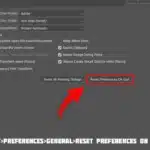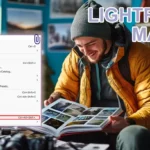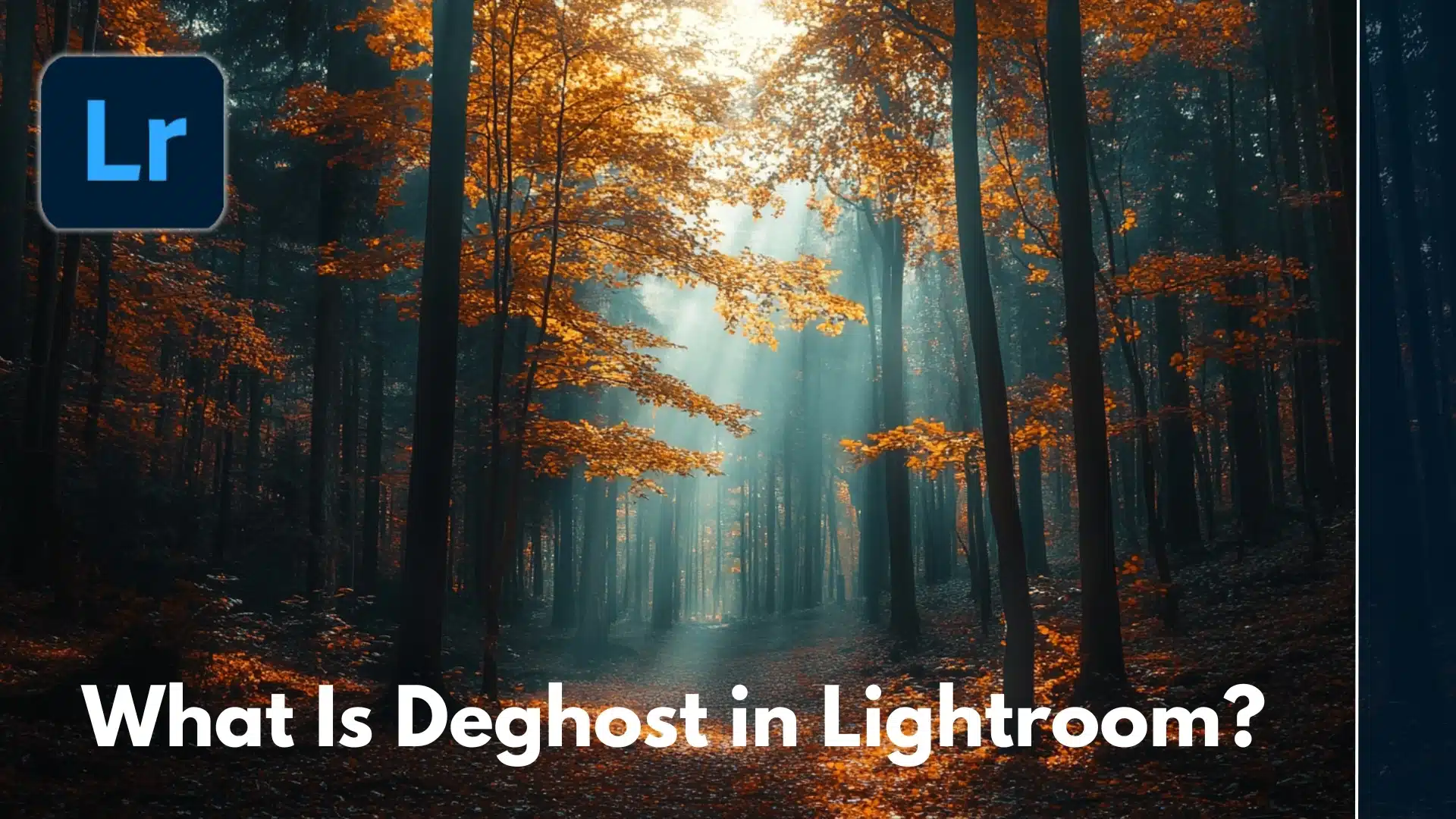
As a photographer, you know the struggle of capturing flawless images in dynamic settings. One common issue is dealing with moving subjects or fluctuating light conditions, which can lead to unwanted ghosting effects in your photos. Thankfully, Adobe Lightroom provides a solution through its Photo Merge feature. But what is Deghost in Lightroom?
In this blog, I’ll explain what Deghosting is and how it works. This technique will enhance your images by eliminating pesky ghosting artifacts. Whether you’re a seasoned pro or a hobbyist eager to refine your photo editing skills, understanding this tool can enhance your final images. Let’s dive into the details!
Table of Contents
Understanding Deghosting in Lightroom: What Is It and How Does It Work?
What Is Deghosting in Lightroom?
How Deghosting Works
When you use Lightroom to merge HDR images, the deghosting feature compares the bracketed exposures to identify areas where movement occurred. Instead of combining all exposures, Lightroom selects a single exposure for those areas to eliminate the ghosting effect. The software allows you to choose from different deghosting levels: Low, Medium, and High. Your choice depends on the amount of movement detected between the exposures.
Key Steps in Using Deghosting:
- Capture Photos: Start by capturing a series of bracketed images of the same scene, each with different exposure levels. These are typically RAW files to retain the maximum amount of data for merging.
- Import to Lightroom: Load the original raw files into Lightroom Classic and select the images you want to merge.
- HDR Photo Merge: Use the HDR photo merge feature by selecting 'Photo Merge' > 'HDR'. This opens the HDR Merge window.
- Adjust Deghosting Settings: In the HDR preview window, you can select the deghosting level. Lightroom highlights the affected areas with a deghost overlay, so you can see where the adjustments will be made.
- Merge: After setting your preferred deghosting level, click the Merge button to process the image. The result is a merged HDR image free from ghosting artifacts.
Practical Tips for Effective Deghosting
| Tip | Action/Advice | Result |
|---|---|---|
| Select the Right Deghosting Intensity | Start with the Low setting. If ghosting persists, gradually increase to Medium or High. Be cautious, as higher settings can introduce artifacts. | Achieves a natural-looking HDR photo with minimal ghosting. |
| Examine Final HDR Photo | After merging, carefully review the image, focusing on areas with movement and shadow edges for residual ghosting. | Ensures ghosting artifacts are eliminated effectively. |
| Enable Auto Align & Auto Tone | Turn on Auto Align to correct slight exposure misalignments and Auto Tone to ensure balanced light and color across the image. | Fixes misalignment and balances the dynamic range. |
| Save as DNG Format | Save the merged image as a DNG file, retaining all adjustments and allowing for further fine-tuning in future edits. | Preserves image quality and edits for advanced post-processing control. |
- Choose the Right Deghosting Level: Start with the Low setting. If ghosting persists, gradually increase to Medium or High. Be mindful that higher settings may introduce artifacts in the merged photo.
- Review the Merged HDR Image: After merging, carefully inspect the image in the develop module. Pay attention to shadow edges and areas with significant movement, as these can sometimes exhibit residual ghosting.
- Auto Align and Auto Tone: Enabling Auto Align ensures that slight misalignments between exposures are corrected, while Auto Tone helps balance the dynamic range across the merged photo.
- Save as DNG File: Lightroom typically saves the merged photo as a DNG file, preserving all adjustments and allowing for further fine-tuning in post-processing.
Limitations and Considerations
While deghosting in Lightroom HDR merge is powerful, it’s essential to use it judiciously. Overusing the High setting can lead to unnatural transitions between static and dynamic areas. It affects the overall quality of the blend pictures and the complete image. Additionally, remember that deghosting can sometimes reduce the benefits of high dynamic range. This occurs by limiting the blend of exposure levels in areas with movement.
How Do You Create an HDR Image with Deghost in Lightroom?
Creating this in Lightroom, especially when dealing with moving elements, requires careful attention to the deghosting feature. This process ensures that your HDR photo is free from ghosting artifacts and maintains a natural look. Here’s a step-by-step guide to help you through the process:
Step-by-Step Guide to Creating an HDR Image with Deghost in Lightroom
Capture Your Bracketed Exposures
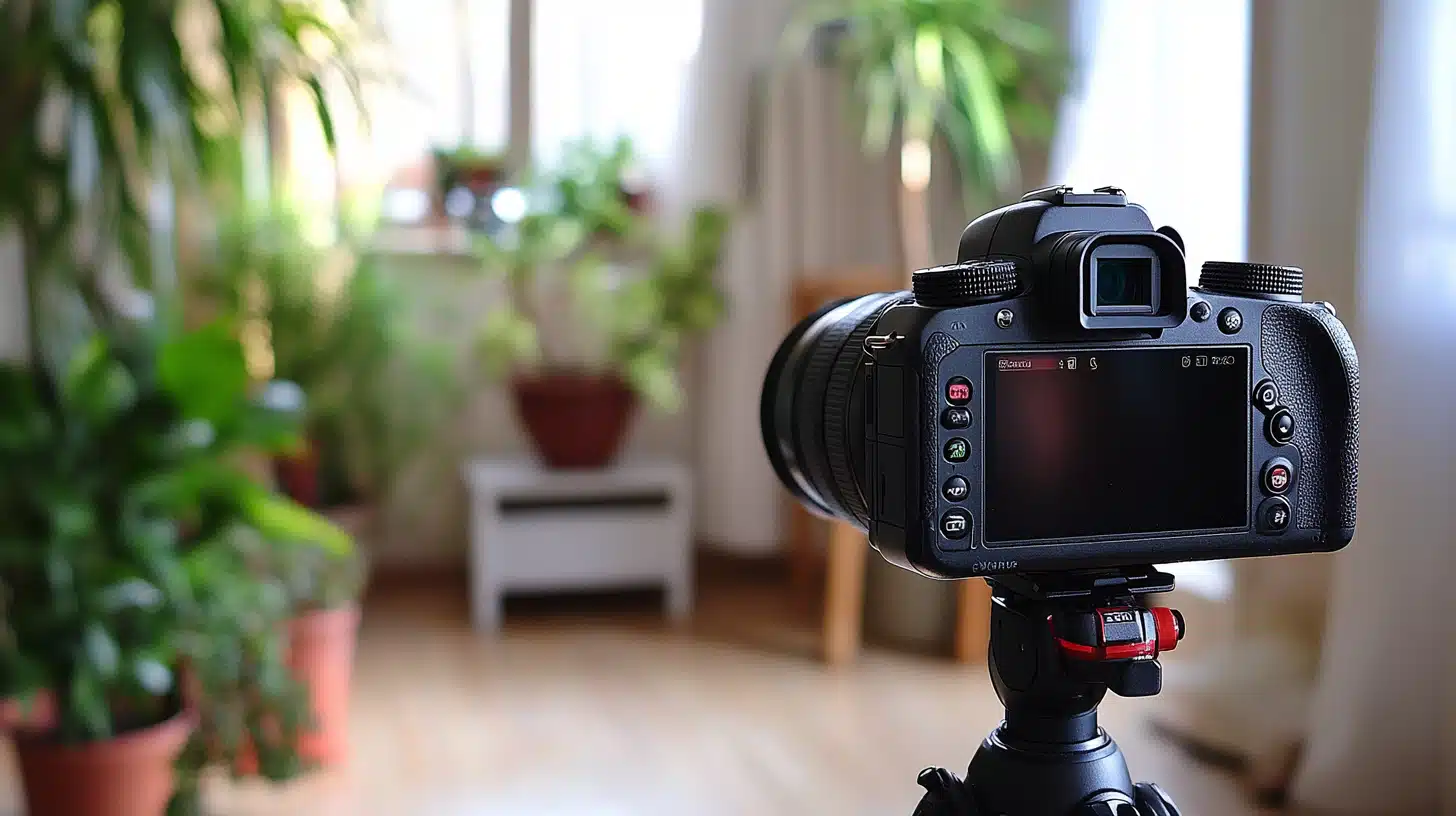
- Use a Tripod: To ensure consistency across your shots, always use a tripod when capturing bracketed exposures, minimizing the risk of misalignment and improving the accuracy of the HDR merge.
- Bracket Your Exposures: Capture a series of images with different exposure values (EV) to help fix overexposed photos. Typically, you should take three to five exposures ranging from underexposed to overexpose. This will allow you to cover the full dynamic range of the scene.
- RAW Files: Save your images as RAW files to retain maximum detail and flexibility in post-processing, allowing for greater control over adjustments and corrections.
Import and Prepare Your Images in Lightroom

- Import Your Images: Load your bracketed sequence of photos into Lightroom Classic. Organize them in the Library module for easy access.
- Select Your Images: Highlight the images you wish to merge. Ensure these are the bracketed shots intended for HDR merging.
Initiate the HDR Photo Merge
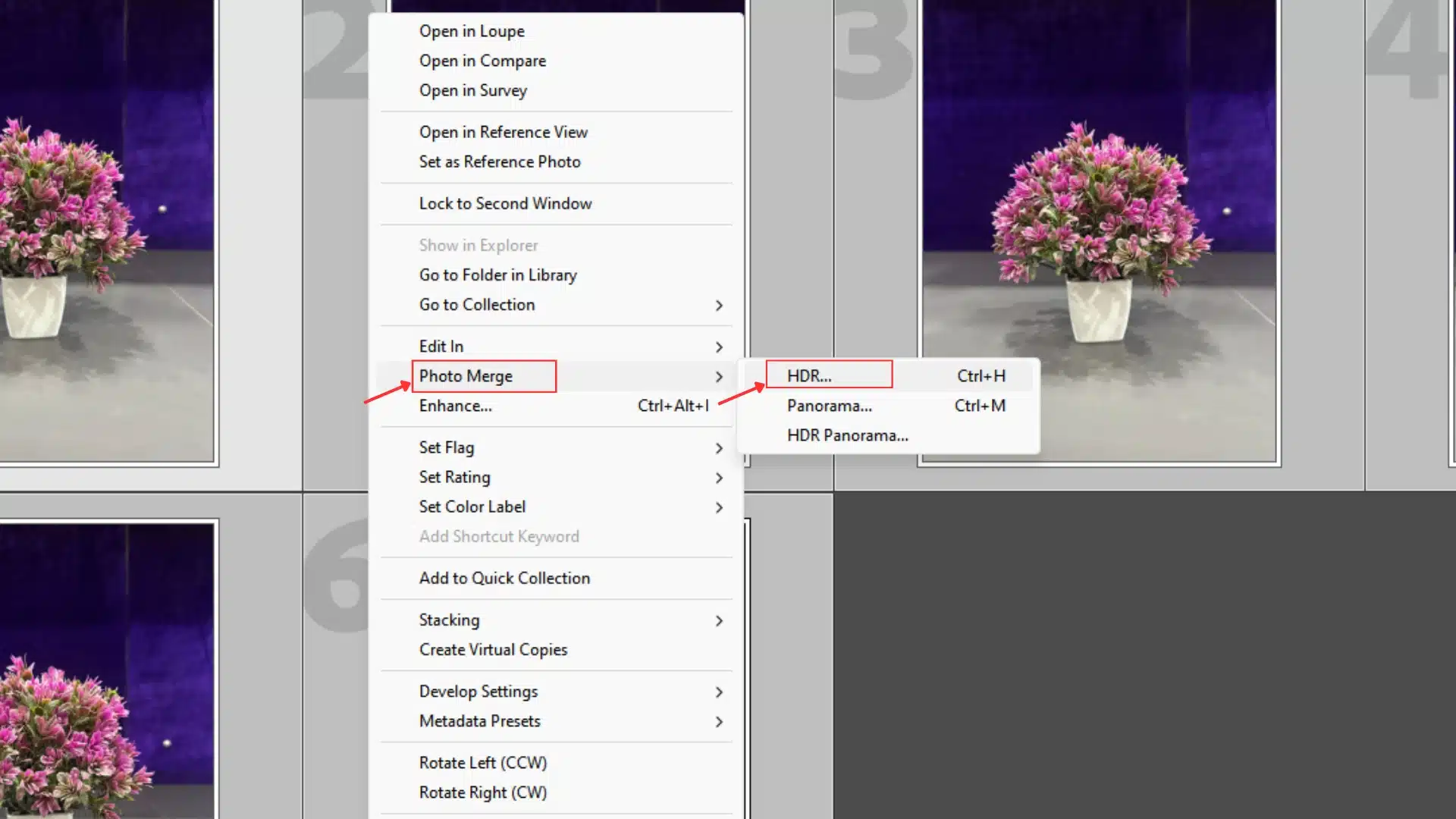
- Access the Photo Merge HDR Feature: With your images selected, right-click and choose ‘Photo Merge’ > ‘HDR,’ or use the shortcut (Ctrl+H for Windows, Command+H for Mac).
- HDR Merge Preview Window: In the preview window, you’ll see your images combined with the default settings. This is where you’ll make critical adjustments.
Adjust Deghosting Settings
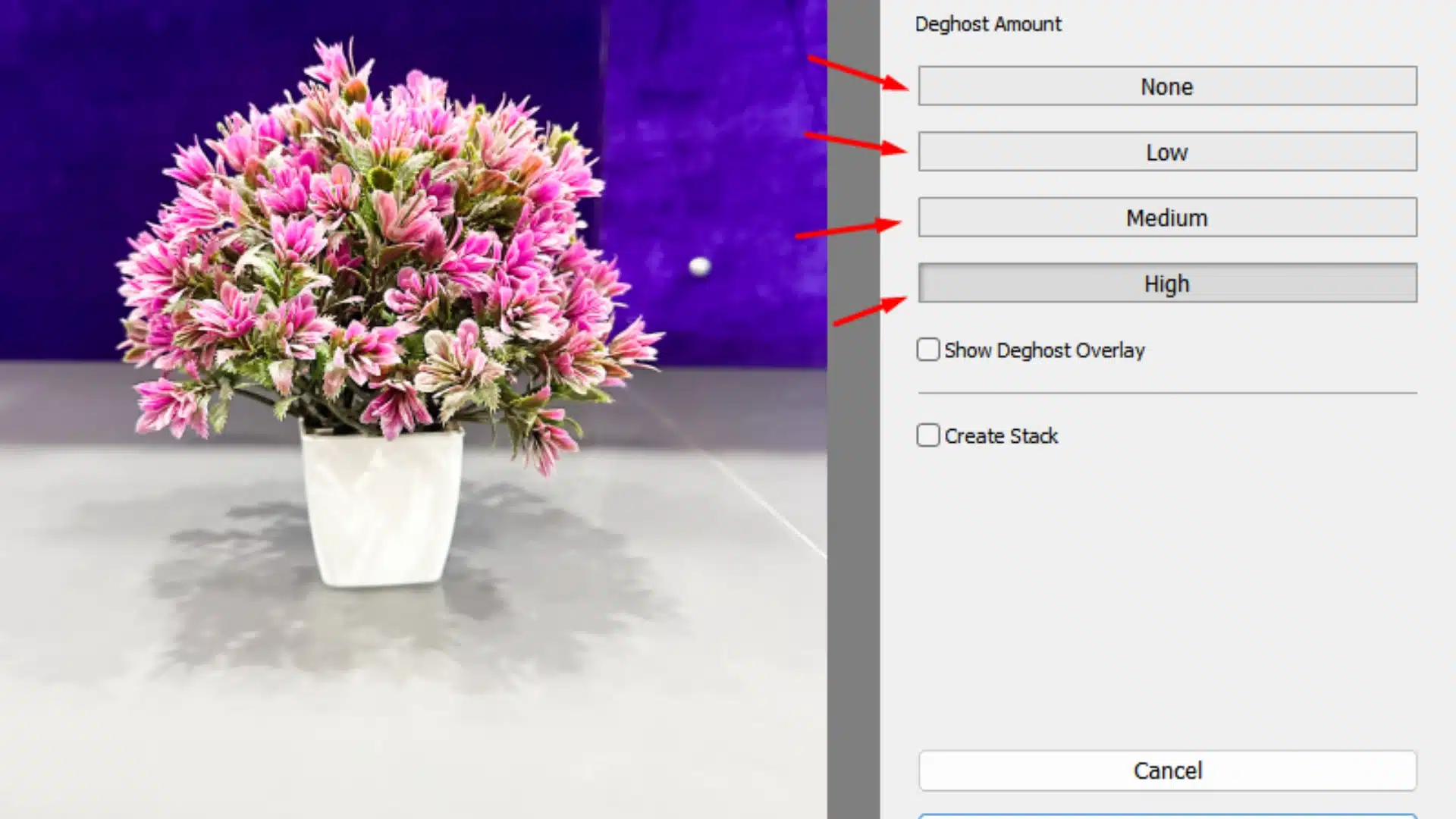
Choose the Appropriate Deghosting Level: In the HDR Merge window, you have the option to adjust deghosting levels, Low, Medium, or High, based on the amount of movement in your images.
- Low: Ideal for minimal movement, like slight leaf flutter.
- Medium: Use when there’s moderate movement, such as waves or people walking.
- High: Necessary for significant movement, like fast-moving clouds or animals.
- Deghost Overlay: After selecting a deghosting level, Lightroom will display a deghost overlay in red, indicating areas where ghosting was detected and corrected.
Finalize and Merge the Images
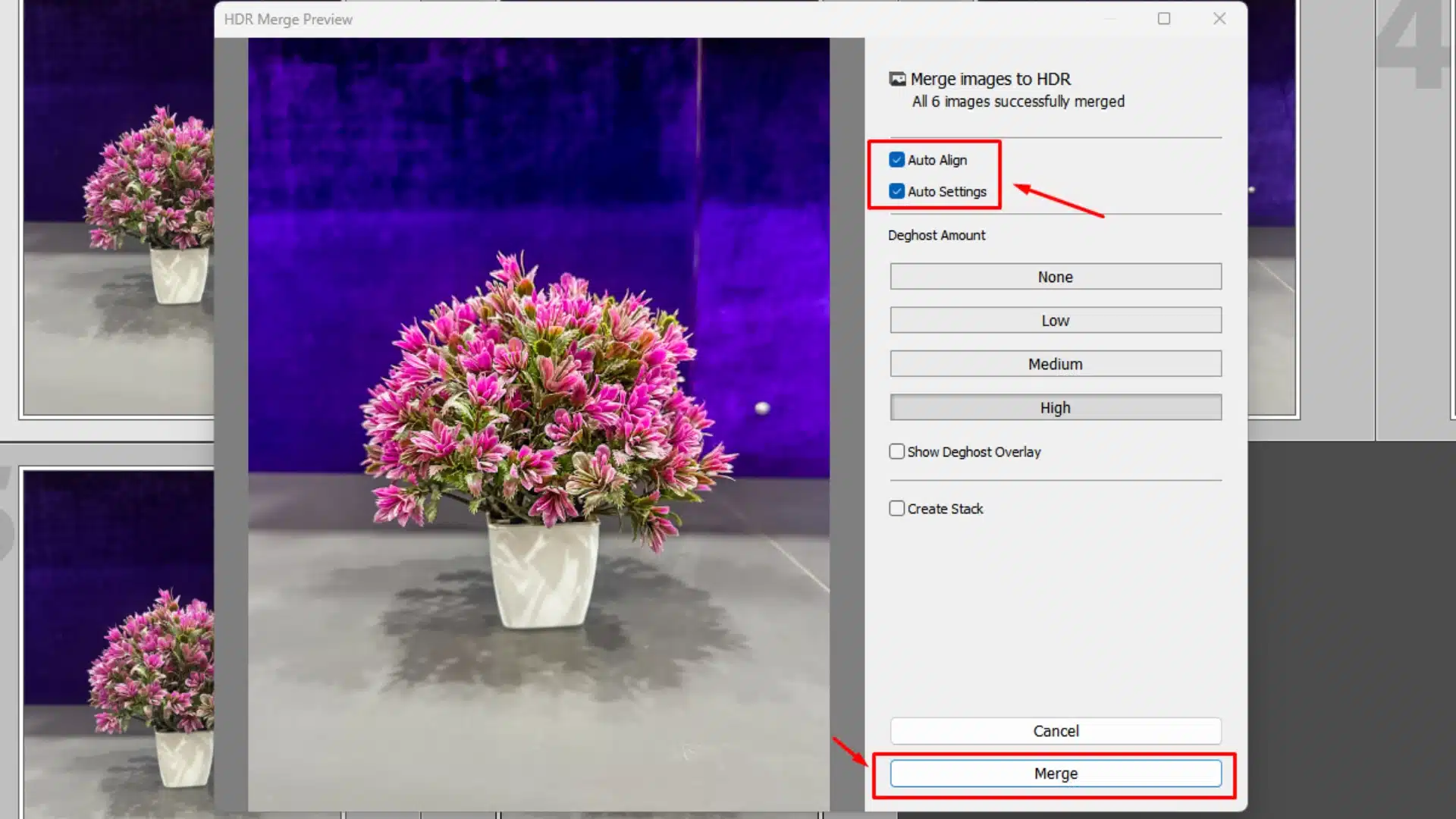
- Auto Align and Auto Settings: Ensure Auto Align is checked to correct any slight misalignments between exposures. You can also enable Auto Settings to allow Lightroom to automatically adjust tone and color.
- Merge the Images: Once satisfied with the settings, click the Merge button. Lightroom will create a merged HDR image, typically saved as a DNG file.
Post-Merge Adjustments

- Review in the Develop Module: After merging, review your final image in the Develop module. Adjust settings like exposure, contrast, and color balance to fine-tune your image.
- Check for Residual Ghosting: Inspect areas with significant movement to ensure ghosting has been adequately addressed. If necessary, consider re-merging with a different deghosting level.
Practical Tips for Creating Optimal HDR Images
- Use a Remote Shutter Release: To avoid camera shake during exposure bracketing, use a remote shutter release or the camera’s timer function.
- Balance between Deghosting and HDR Effect: While deghosting removes unwanted artifacts, it might slightly diminish the HDR effect in areas of significant movement. Balance the deghosting level to maintain the dynamic range while minimizing ghosting.
- .Manual Adjustments Post-Merge: Sometimes, additional manual adjustments in Lightroom and Photoshop might be necessary to refine areas where the automatic deghosting didn’t fully resolve issues.
By following these steps, you can create HDR images in Lightroom that effectively utilize the deghosting feature to remove unwanted artifacts while preserving the full dynamic range of your scene.
FAQ about Deghost in Lightroom

What is ghosting in HDR Lightroom?
Ghosting in HDR Lightroom refers to the visual artifacts that occur when there is movement between the multiple exposures used to create an HDR image. This can happen when subjects like people, animals, or leaves move during the exposure sequence. The resulting HDR image may show these moving objects as semi-transparent or blurred, creating a ghost-like effect that can detract from the image’s quality. This effect is particularly noticeable in scenes with fast-moving elements or windy conditions. Fortunately, Lightroom’s Deghosting feature can help correct these artifacts by aligning the exposures and reducing or removing the ghosting effect.
How to remove ghosting in Lightroom?
To remove ghosting in Lightroom, use the Deghosting feature during the Lightroom HDR merge process:
- Select Your Bracketed Photos: Begin by importing the series of bracketed images you want to merge photos into Lightroom. Ensure that these images were taken with different exposure levels to cover the full dynamic range of the scene.
- Start HDR Merge: Once your images are imported and selected, navigate to the 'Photo Merge' option in the top menu and choose 'HDR'. This action opens the HDR Merge Preview window, where you can adjust settings before finalizing the merge.
- Apply Deghosting: In the HDR Merge Preview, look for the Deghosting options within the HDR Photo Merge feature. You'll find three levels to choose from: Low, Medium, and High. Select the appropriate level based on the amount of movement present in your images. For minimal movement, such as a slight breeze, 'Low' might suffice.
- Review and Adjust: After applying the Deghosting settings, review the HDR merge preview to ensure that the ghosting has been effectively addressed. You can make additional adjustments if necessary by fine-tuning the deghosting level or re-evaluating the selected exposures.
- Finalize the Merge: Once you're satisfied with the preview, click 'Merge' to process and create the final HDR image. Lightroom will compile the images, applying the deghosting corrections and producing a final photo with enhanced dynamic range and minimal ghosting.
By following these steps, you’ll ensure that your HDR image is free from distracting ghosting artifacts, resulting in a clean and balanced final photograph.
What does HDR merge do in Lightroom?
The HDR merge in Lightroom combines multiple photos taken at different exposure levels into a single image using the HDR Photo Merge feature. This process enhances the dynamic range of the final photo, capturing details in both the highlights and shadows that would be impossible in a single exposure. HDR merge is especially useful for scenes with extreme contrasts, like sunsets or indoor scenes with bright windows, resulting in a more balanced and detailed final image.
Additionally, this technique helps preserve texture and depth in both bright and dark areas, making your photos appear more vivid and lifelike. By integrating multiple exposures, Lightroom’s HDR merge ensures that no important details are lost, even in challenging lighting conditions.
Should I edit in HDR on Lightroom?
Editing in HDR photography on Lightroom is beneficial if you’re working with pictures that have a large dynamic range, such as landscapes or scenes with significant contrast between light and dark areas. HDR editing allows you to capture and fine-tune details in both shadows and highlights, resulting in a more vibrant and realistic image.
However, it’s essential to use HDR Photo merge thoughtfully, as over-processing can lead to unnatural results with excessive detail or color distortion. Striking the right balance ensures your final image retains a natural and appealing look while showcasing the full range of your scene.
Conclusion: Deghost in Lightroom
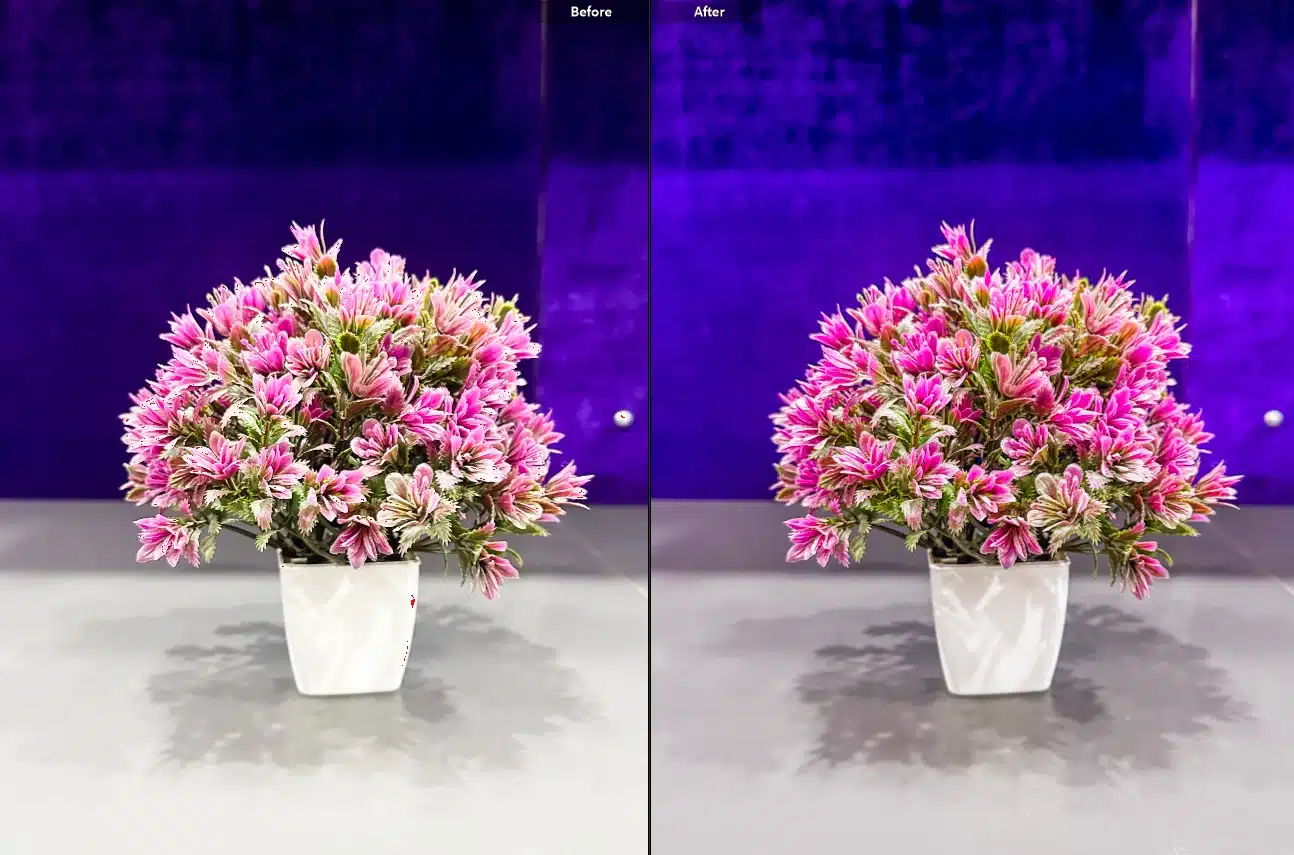
Creating natural-looking HDR images in Lightroom has transformed how I approach my photography. When I worked on flower arrangement shot, the lighting variations could have easily caused ghosting issues.
To enhance your photo editing skills and master essential tools in lighroom like HDR merging and deghosting, check out our Lightroom Course and Photoshop Course.
If “What Is Deghost in Lightroom? Tips for Achieving Flawless Images” article has helped you, then Like and Share it with your friends
Have a nice photoshoot!
Read more about: Photo Editing with Lightroom and Photoshop







